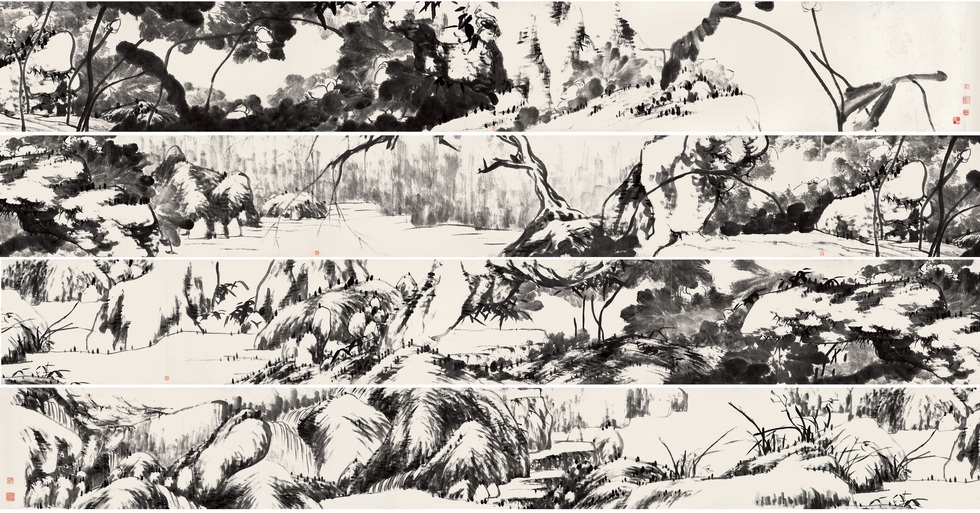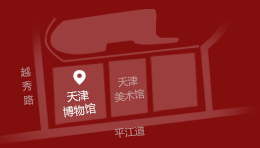清 朱耷 河上花图卷
清康熙三十六年(1697)
纸本 墨笔
纵47厘米 横1292.5厘米
清代初期的中国画坛活跃着弘仁、髡残、朱耷、石涛四位僧人画家,画史上合称“四僧”。他们的绘画在继承传统的基础上,大胆创新,主张师法自然造化,与当时画坛正统风格相距甚远,具有鲜明的艺术风格。在这四人当中尤以朱耷的人生与艺术最具传奇色彩。
朱耷(1626—1705),江西南昌人,为明江西宁献王朱权的九世孙。明亡后出家为僧,法名传綮,曾经使用的号有很多,最为著名的则是在他弃僧还俗后使用的“八大山人”。
朱耷的绘画以水墨为多,用笔恣意纵横,浑厚酣畅,花鸟画成就突出。他在学习陈淳、徐渭等前代写意大家的同时,在绘画实践中逐渐突出用笔奇峭,构图险怪,造型夸张的特点,形成了强烈的个人风格,对后世的写意花鸟画发展产生了深远的影响。在他的花鸟画作品中,现收藏于天津博物馆的《河上花图》可谓精品中的精品。
《河上花图》卷高47厘米,长近13米,作者以水墨描绘了沿河而生的荷花、兰竹和坡石流水,画面中充满了强烈的节奏感,笔墨的控制自然流畅,纵逸的笔触中将作者澎湃的激情展现在宣纸之上,将中国水墨画的形式美呈现得淋漓尽致。全图起伏跌宕,浑然一体,气韵贯通,宛若一首华美的乐章,实则历经四月画成。作者以纯熟的技法作写意荷花,笔墨交叠,浓淡互破,洇润渗化,清气满纸。荷花用笔清圆,荷茎以中锋写出,笔力内蕴,如绵里裹铁。坡石用秃笔枯墨勾皴,苍润浑厚。《河上花图》中从生机勃发的荷花始,经历陡壁山崖、枯木乱石,再见孤兰衰草竹叶夹生,最后以高涧瀑流结尾似乎正隐喻着作者多舛的人生与不凡的艺术。
图后有朱耷以行书自题歌行体诗《河上花歌》,描写了姿态万千的荷花,及作者与诗仙李太白就荷花对话,全诗历史典故与佛道用语较多,情感恣肆而想象丰富,书法流畅老辣,体现出朱耷作为书法家与诗人的成就。
Flowers upon a River
Zhu Da(c. 1626-1705)
Qing dynasty, 36th year of the Kangxi period(1697)
Hand scroll, ink on paper
Height 47cm, Width 1292.5cm
Qing dynasty artist Zhu Da painted this monumental hand scroll when he was 72 years old, in 1697, during the reign of Emperor Kangxi. The technique is exquisitely practised, with fast and free brushwork and smooth luxuriant ink. The verse, calligraphy, painting and seals are all exceptional. Laden with the poetic rhythm of Chinese painting, undulating free and fluid imagery and beautiful cadence, this hand scroll is an exemplary work of free sketch ink painting. It is also the most classical of Zhu Da’s surviving works. The end of the hand scroll is inscribed by the artist with a self-authored poem “ode of the Flowers upon the River”. The verse has great literary merit and the calligraphy is expressive and unrestrained, perfectly matching the imagery. In an empty space left for colophons on the scroll, Xu Shichang has added a line in semi-cursive script which reads “in the cold mist and light ink, one seems to see the painter himself”. There are also colophons by Yong Xing and Xu Naipu from the Qing dynasty, as well as from several modern figures including Xu Shichang.
Zhu Da was ordained with the Buddhist name Zhuan Qi, had the style name Xue Ge, and he personal name Badashanren(Man of Eight Great Mountains). He was a native of Nanchang in Jiangxi Province and a descendant of the Ming dynasty Prince Zhu Quan of Ning. He had a talent for verse and prose, and excelled in semi-cursive script. He possessed a unique unembelished and smooth calligraphic style. Zhu Da was an accomplished painter of landscapes, and excelled in free sketch bird and flower paintings. His liberated and vigorous style of painting was characterised by exaggerated imagery and boundary-breaking compositions. Zhu Da was one of the Four Monk Painters of the early Qing, along with Yuan Qi, Hong Ren and Kun Can.








 电话:022-83883000
电话:022-83883000 传真:022-83883088
传真:022-83883088 地址:天津市河西区平江道62号
地址:天津市河西区平江道62号










